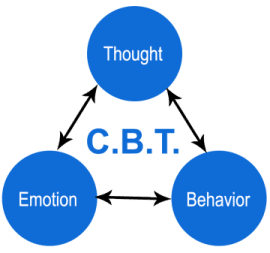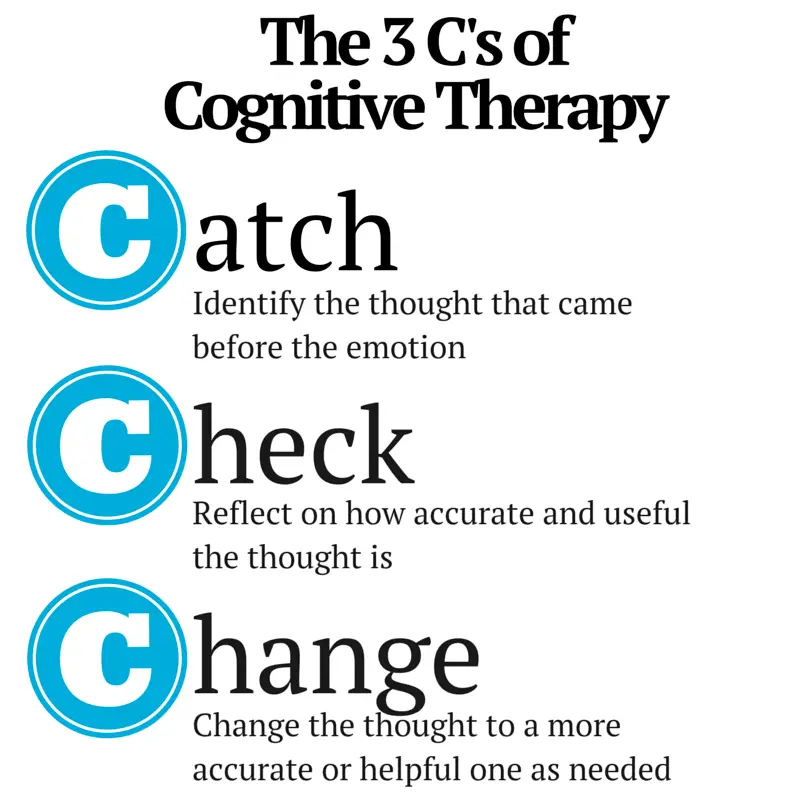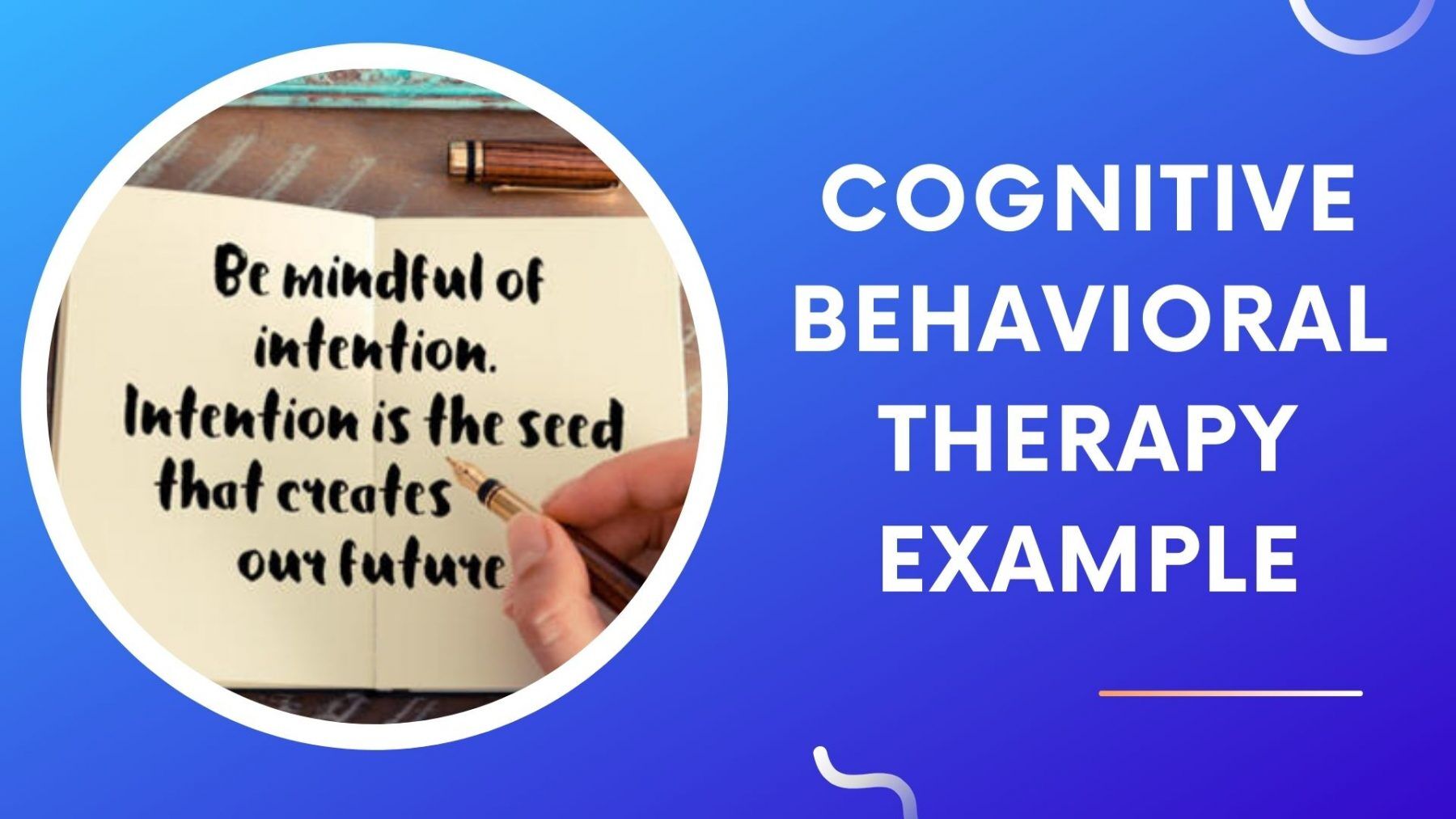Would you like to see a Cognitive Behavioral Therapy example (CBT) in action?
CBT has been proven effective in the treatment of OCD, depression, eating disorders, and anxiety disorders.
It is a structured program that provides an individual with tools to change their patterns of thinking, mental illness, and behavior.
CBT is also popular because generally speaking it is shorter in duration than other types of therapy.
In this article I’ll provide a Cognitive Behavioral Therapy example so you can see how CBT techniques flow together.
The Cognitive Behavioral Therapy example will be about a woman who struggles with:
- Food
- Anxiety
- Boundary setting with her partner and coworkers.
In particular in this Cognitive Behavioral Therapy example below, I’ll weave together journaling, reframing, role-playing and other CBT techniques!
These examples will help you see how CBT techniques fit together so you stay committed to your healing and recovery.
Please note this blog post assumes you already know something about CBT. If you need an overview of CBT read here.
If you stay inspired and committed, then the end of binge eating and the beginning of new-found mental freedom are right around the corner!
Are you ready? Let’s give some examples and discuss!
Quick Refresher – What Is Cognitive Behavioral Therapy?
Let’s cover CBT real quick. Hopefully this little refresher will make the examples below super clear!
Here’s in a nutshell is what CBT focuses on:
CBT is based on the idea that your thoughts influence how you feel.
In the example above, there are two ways of thinking. One way of thinking leads to happiness, while the other way of thinking leads to misery.
In terms of binge eating struggles, have you ever ‘thought’ you made a mistake, and then binged because you ‘felt guilty’ you made a mistake?
Oftentimes people who struggle with food will think ‘Oh, I’ve screwed up today. Since I’m already a failure, why not binge because today is already a failure? I’ll start fresh tomorrow.’
Does this thought pattern sound familiar to you?
But doesn’t this guilt start with a thought?
The problem isn’t binge eating per se, but rather that your thoughts about failure are the real problem. Eating struggles are mental health problems at their roots!
In this example, you feel defeated and sad by ‘thinking’ your whole day is ruined.
Negative thoughts make you feel bad, and feeling bad then in turn influences you to binge.
See how binge eating starts with your negative thoughts? And your negative thoughts aren’t even true!
How can your whole day ever be entirely ruined by one silly mistake like an extra calorie or having an extra cookie?
So instead of trying to white knuckle yourself into not binge eating, or telling yourself ‘I won’t do that again’ and then doing it again, again and again …
Let’s tackle binge eating at the source by changing the way you think.
Obviously changing the way you think is easier said than done.
To change your way of thinking, you’ll probably need to combine several different CBT techniques.
To show you how various CBT techniques complement each other, here are some examples!
What Are Examples Of Situations Where Cognitive Behavioral Therapy Techniques Help?

In the following sections, I’m going to walk you through different situations involving boundary setting, issues of anxiety, and issues about food.
Remember, this example is about one person who, like all human beings on planet earth, struggles with multiple different problems.
These could be independent problems – like relationship issues and anxiety – but obviously problems oftentimes come together in batches!
In this situation, we’ll start with person who has trouble with boundary setting. Whenever she tries to set boundaries, she gets anxious, and experiences other problems.
This example will show CBT helps with anxiety and other struggles, ultimately winding our back to successfully setting a boundary!
Are you ready to see how various CBT techniques intertwine to affect multiple different problematic aspects of your life?
Finally, here’s a quick list of CBT techniques:
- Self monitoring: via journaling
- Cognitive restructuring: by challenging your thoughts
- Exposure: to uncomfortable things help you tolerate them
- SMART goals: or intention setting
- Mindfulness: being aware of thoughts and feelings
- Role playing: to help clarify thoughts and make boundary setting easier
See if you can spot the techniques in the example below!
Let me know in the comments if you ‘get’ how CBT works by saying ‘Got it!’.
Boundary Setting and Saying ‘No’
It’s very common in eating struggles to also struggle with boundary setting.
A boundary setting problem is where you give everything to other people, but don’t keep anything to yourself.
On one hand you’re supportive, caring, and available for your family, partners and friends.
On the other hand you leave nothing for yourself, nothing but harshness and meanness.
You’re harder on yourself than anybody else!
How do you use CBT techniques to shift your boundary-setting behavior?
Scenario:
You’re about to say ‘Yes’ to something, just like you always do, but this time you pause and practice mindfulness.
Let’s say you’re exhausted after work one day, but you made a couples dinner plan with another couple.
Your partner, and the other couple, are all looking forward to having a nice dinner and chatting.
However, in this situation you are dead tired, beat, very low on sleep and desperately need rest.
Normally you would suck it up and have dinner – all the while ruefully regretting your decision and wishing the entire dinner you weren’t there.
But this time around you’re practicing CBT techniques!
This time instead of immediately getting out of your car once you return from work, you spend a few moments of quietude in your car.
Please note that in the beginning of CBT, you’ll often be asked to journal what you’re experiencing.
So while you’re in your car, you take your journal or the Eating Enlightenment app, and make a few notes:
- You feel pressure in your chest because of the expectations your work and friends
- You find yourself thinking an automatic thought, ‘If I don’t show up for dinner, then people will be really disappointed in me.’
Then, after journaling your feelings and thoughts, you realize you’re feeling anxious right now, along with some other emotions like fatigue and frustration.
Anxiety – Learning to Relax

Anxiety is a really common problem.
Did you know the Anxiety and Depression Association of America estimates that 40 million Americans have an anxiety disorder?
In this situation, you’re anxious about saying ‘No’.
Remember how your partner and another dinner couple are waiting for you to get back from work so you four can have a nice dinner?
But you’re dead tired and you know what’s best for you is to rest. But you are afraid of disappointing them!
The very thought of telling your partner that you’ll have to cancel tonight makes you feel incredibly anxious.
(At first you didn’t even realize you were anxious, but after practicing the CBT technique of journaling you are more aware of your emotions).
Fortunately during a session with your therapist you have been taught relaxation techniques – like deep breathing or tapping – so you are better prepared to handle this anxiety.
Once you recognize you’re feeling anxious, you practice some deep breathing exercises and even tap yourself on the forehead like your therapist may have suggested!
(Yes, I frequently recommend clients to practice tapping their forehead and deep breathing. It really works to reduce anxiety!)
After practicing these techniques, you notice that while your anxiety doesn’t evaporate, you can manage your anxiety.
You don’t have to let anxiety rule your life.
Successfully dealing with anxiety in this slightly less anxious situation then gives you more confidence that you can handle a more anxious situation – like when you eventually say ‘No’ to your loved one.
Exposure, Gradually Reaching Your SMART Goals, and Learning New Skills

Notice in this situation how you first got a small victory over anxiety.
You’re still struggling with boundary setting which is a harder challenge for you, but so far you’ve journaled your feelings and then you’ve managed your anxious emotions with some relaxation techniques.
You’ve taken things one step at a time and haven’t bit off more than you could chew.
This mini-example demonstrates 3 important principles of CBT:
- SMART Goals
- Exposure
- New Skills
A big part of CBT is gradually making your way towards your goals.
When you gradually try to reach your goals, instead of trying something too hard and failing, you are more likely to succeed.
This is why CBT emphasizes both goal setting and getting appropriate amounts of exposure so that things aren’t too difficult, but so that you’re still challenged.
Let’s see how these 3 Cognitive Behavioral Therapy techniques fit into the example with anxiety.
SMART Goals
First, you have worked with your therapist to come up with a vision and goals you’d like to move towards.
In our situation, let’s say that one of your goals is to be more assertive and to set better boundaries.
Well, part of being more assertive and setting boundaries is challenging your anxiety.
It’s not SMART to just say ‘I want to be more assertive!’ without any sort of breakdown into the components that make up assertiveness!
SMART goals are where you focus on anxiety first, instead of trying to shortcut the process and be successfully assertive right away (without addressing anxiety first).
Exposure
So instead of talking to your loved one about boundaries and trying to be assertive from the very beginning, you start smaller.
By sitting in the car for a few minutes before you go into your house, you are exposing yourself to a small amount of anxiety.
Then, in the quietness of your car, you instead journal your thoughts and feelings out onto paper. This is a great problem-solving technique!
You might also expose yourself to other semi-anxious moments during the day in order to build up your confidence and gain more skills.
Skills
By calming down in the car, you gain a bit more confidence in yourself to handle anxiety.
Now you’re ready to tackle other smaller anxious moments during the day. You’re not quite ready yet to tackle the big anxiety fish of saying ‘no’ to your partner, but you’re getting there!
During the day you continue to journal, and you notice that you’re anxious before lunch.
Why are you nervous before lunch?
Well, most days at 1:30pm, soon after lunch ends, your boss will have the entire team join a Zoom meeting.
Your boss is really unpredictable and you don’t like his/her unpredictability. You realize that the unknown is making you slightly anxious!
Sometimes you overeat during lunch to numb yourself out for the upcoming meeting. You realize that food is a sort of protection you sometimes wear (or eat) to keep yourself safe.
But with the same Cognitive Behavioral Therapy techniques you practiced in the car, you now practice at your desk at work. Pretend this is before covid times!
Now you are gaining skills.
You are seeing how managing anxiety can apply to many different situations, like in the moments before lunch.
Cognitive Reframing – To Overcome The Root Issues

By keeping a journal you start to get a record of your thoughts.
Then working with your therapist, you break apart your anxious thoughts to see what’s true and not true. This process is great for your mental health!
One thought you seem to have is that something ‘bad’ will go wrong.
But upon examination with your therapist, you see that nothing bad has ever happened to you in these team meetings.
While you’re still anxious, you see that your anxiety is not fully supported by evidence.
But you’re not quite ready to say ‘No’ to your loved one just yet.
A part of you feels unworthy, which is a limiting belief you’ve discovered through your journaling and working with your therapist.
It’s almost as though your binge eating makes you feel subhuman. Feeling sub-human, you think you don’t deserve time to care for yourself.
Since you don’t deserve time to care for yourself, this makes setting a boundary with your loved one more difficult!
With your therapist you find that contemplating eating disorder facts helps you reframe your limiting beliefs.
For example, hearing that 10% of American are also diagnosed with Binge Eating helps you realize you’re not so different after all.
If other people who binge deserve rest, love and relaxation – then so do you!
Now you are better able to challenge these thoughts that come up during the day, and feel better about yourself.
Things are really starting to add up now!
Your journaling, mindfulness, and cognitive restructuring have really helped you to manage your food intake and reduce binges.
Now you are building your confidence and skills.
- Reducing semi-anxious situations like transition moments such as in your car or before lunch
- These skills now spill over into other areas of your life like eating
The more often you avoid binge eating and fight back anxiety, the greater your confidence grows.
You’re becoming ready to step up and say ‘No!’.
RolePlaying – Getting to No!
You know you should say ‘No’ because you’re feeling exhausted, but you have a hard time articulating how you feel.
You’re just not sure what to say.
Instead of putting tons of pressure on yourself to say ‘No’ and be calm at the same time, instead your therapist suggests an experiment.
You are you, and the therapist will pretend to be your partner.
So you roleplay the situation with your therapist! That’s right, roleplay!
An Cognitive Behavioral Therapy example within a Cognitive Behavioral Therapy example! Wow very meta!
- You imagine your therapist is your partner, and that you are exhausted and fatigued.
- Imagine the setting of dinner time, the expectations of your friends …
- You try to tell your therapist what you’re feeling and how you need to rest tonight instead of going to dinner
Even though you’re talking things through with your therapist, you struggle to find some phrases that feel authentic and appropriate to you.
Your therapist suggests to lighten up and have fun with the roleplay!
What would happen if you said ‘No’?
Well, only one way to find out, right? It’s just an experiment, let’s see what happens!
You decide, in the safety of this roleplaying therapeutic bubble, to say ‘No!’.
Even though you’re speaking to your therapist, this still feels awkward, but you successfully say ‘No!’.
Your therapist tries to pretend he/she is your partner, and replies ‘Of course, that’s not a problem. We’ll have dinner another night.’
This response feels like something your partner might say too!
Upon reflection in therapy, it doesn’t seem likely your loved one will be disappointed in you.
Your loved one wants the best from you and generally speaking, would totally be fine if you wanted some space to deal with your exhaustion.
Now you have expressed ‘No!’ during a roleplay you feel even more confident to actually saying ‘No’ when it counts!
You’re back in your car, feeling like a calm zen monk who is ready to stand up for herself to protect her inner peace.
You calmly express yourself to your partner, and because you are calm and present, he/she is also more calm and present.
Your conversation goes well!
Do you see how all these various Cognitive Behavioral Therapy techniques connect?
And how these Cognitive Behavioral Therapy techniques oftentimes don’t fully work the first time, but by learning and adapting, you can get to the root problem?
For example, the problem in the beginning was boundary setting. But then upon deeper reflection there were issues of anxiety and food too.
Using the same Cognitive Behavioral Therapy techniques, you and your therapist worked through these deeper issues and then you became ready to finally have that conversation about boundary setting.
Can You Do Cognitive Behavioral Therapy (CBT) On Yourself? Concluding Thoughts
To wrap up this article, let me say that you can partially do CBT on yourself.
Obviously mindfulness and journaling are critical parts of Cognitive Behavioral Therapy. You can definitely do these by yourself!
However, overall Cognitive Behavioral Therapy is done best with a therapist.
In particular, it’s hard to roleplay and explore your beliefs by yourself! It’s much more effective to work through these types of situations and potential responses and actions with a therapist.
Which of these Cognitive Behavioral Therapy examples was your favorite? Let me know in the comments below!




